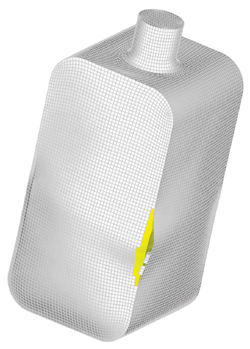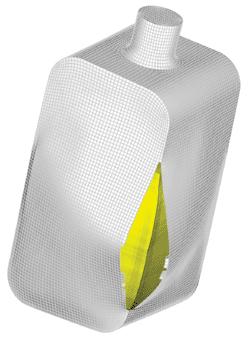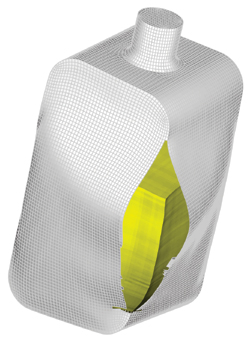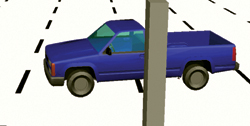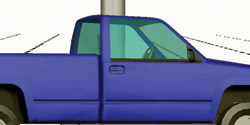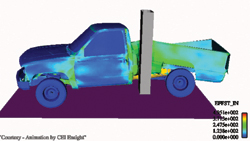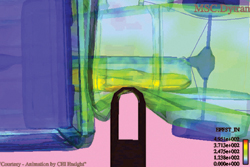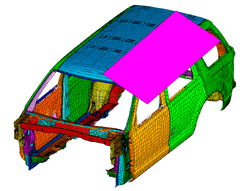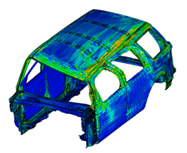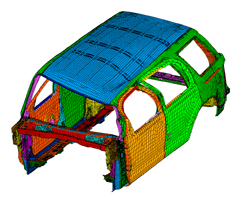Latest News
November 1, 2004
By Louise Elliott
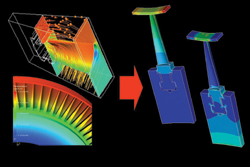 Figure 1: An example of how ANSYS can combine CFD and structural analysis. Here,a CFX analysis of air movement and heat around the turbine blades is followedwith mechanical structural and vibration studies. Images courtesy of ANSYS, Inc.
Figure 1: An example of how ANSYS can combine CFD and structural analysis. Here,a CFX analysis of air movement and heat around the turbine blades is followedwith mechanical structural and vibration studies. Images courtesy of ANSYS, Inc.
The high end of the FEA spectrum has tools that can simulate and predict theresults of underwater explosions on the hull of a ship or—using the same principles—predictwhat will happen to a plastic bottle of detergent dropped on the floor. They canindicate whether a gas turbine in a power plant will survive its operating conditionsfor its entire planned life. They can also simulate a pickup truck skidding andcrashing broadside into a pole, and predict whether the gasoline sloshing aroundin the gas tank will leak and explode, or whether the passengers in a vehiclewill survive a rollover accident that buckles the vehicle’s roof.
A few years ago, modeling and meshing such problems would have strained the abilitiesof a dedicated analyst with a Ph.D. and boggled the solution capabilities of asupercomputer. But the problems described above are real problems that have beensolved by Abaqus, ANSYS, MSC.Software, and NX Nastran from UGS, respectively—allmultidisciplinary, multiphysics general-purpose FEA codes.
“High-end FEA comes into play when you want to know the real-world effects ofreal-world events,” says Ken Short, technical marketing director for Abaqus. Dr.Paul Lethbridge, product manager for multiphysics for ANSYS, says that complexproblems all share large size, dependence on meshing techniques, and, nowadays,MCAD model transfer.
|
|
|
Figure 2: This series shows the buckling response of a plastic bottle filledwith detergent on impact through the instant of rupture. Figure 2A is the deformedshape after 12.6 ms, while Figure 2B shows the deformation after 14.4 ms. Figure2C shows the deformation shape after 18 ms. Images courtesy of Abaqus, Inc.
CFD and Structural Analysis
The gas turbine example above came from ANSYS. It combines the analysis of airmovement and heat around the turbine blades by CFX CFD (computational fluid dynamics)software, followed by use of the resulting loads for mechanical structural andvibration studies (see Figure 1).
“Turbines undergo massive inertial stress, and if you have a blade failure whilerunning, the turbine is pretty much toast,” Lethbridge says.
At one time, engineers would simply have looked for the torque created when air,water, or steam was forced through the turbine—followed up with decades of experiencewith the devices. “But this approach limits designers—]it] gives them no informationabout what would happen if they changed the shape of the blades, and doesn’t letthem test new theories,” Lethbridge says.
To expand their knowledge, he says, “If analyses such as CFD and structural studiesare coupled, and everyone working on the analyses shares information, engineerscan try out new designs to improve performance and reduce fatigue.”
In the case of the gas turbine, an engineer can model the fluids surroundingthe structure in CFX, work out conjugate heat transfer in that program as well,and share temperature and pressure loads with colleagues who can input the informationfor their mechanical analyses.
Different engineers may work on the two sets of analyses, but because the twodisciplines are linked in ANSYS, everyone has access to the results. Lethbridgesays, “It takes about half an hour to do a typical CFD run, and the mechanicaltakes less than 10 minutes. The team will get realistic results from a varietyof different scenarios within a few hours.”
|
|
|
|
Figure 3: This series of images analyzed a skidding truck colliding with thepole. Figures 3A and 3B (at top right and left) provide two different views asmodeled by with MSC.ADAMS. Figures 3C and 3D (above right and left) are MSC.DYTRANdynamic analyses of the collision results on both the truck body and the fueltank, respectively. | |
Fluid Interaction with Explicit Dynamic Nonlinear Analysis
Both the underwater explosion and detergent bottle examples were modeled andsolved with Abaqus. Both examples used explicit dynamic solution methods for thebehavior of transient, highly nonlinear materials along with equation of statemodels for fluid constitutive behavior. (The latter are material models that determinethe volumetric strength of a hydrodynamic material and specify the pressure ofthe material as a function of density and internal energy.)
Although the underwater explosion is a very exotic case that has to account forcavitation effects, shock waves, and more, “the physics for both cases are thesame,” says Short. “While it may be difficult for design engineers to relate tothe explosion example, they can certainly relate to bottles of fluids stackedin a truck and going over a bump.”
He says that detergent bottles have complex physics, but few components—althoughall of them are nonlinear (see Figure 2A, B, and C). “You know the temperatureof the fluid at the time of filling, know how far it will be dropped, how highit will be stacked for shipment. The bottle has a cap with screw threads thatcreate contact issues, is made of plastic, which is highly nonlinear, and hasnonlinear fluid inside it. So you have to account for the fluid-structural interplay.”
Artificial heart valves offer another example of the same physics. “Only thedetergent bottle can be tested physically,” Short points out. “No one will builda submarine and blow it up, or test an artificial heart valve in humans. That’swhy multiphysics analyses like these are so important. They provide realisticvirtual prototypes that can be trusted.
Abaqus partners with Fluent for fluids and structures interaction.
|
|
|
Figure 4: This series uses a full car model developed for NVH analysis to simulatethe damage experienced by an automobile’s roof in a rollover accident. The largerectangle in the top figure defines the ground. The center and bottom figuresshow the damage to the car as the ground pushes into the roof. Images courtesyof UGS Corp. | ||
Motion Simulation Coupled with Explicit Dynamic Analysis
MSC.Software analyzed the skidding truck colliding with the pole—using MSC.ADAMSto model the skid, and MSC.DYTRAN for explicit dynamic analysis of the collisionresults on both the truck body and the fuel tank (see Figure 3A, B, C, and D).
This example requires the use of both capabilities, says Casey Heydari, productmanager for the MSC.DYTRAN line, “because DYTRAN is an explicit code that’s verygood for highly dynamic, short-duration situations—while ADAMS is better suitedto the longer duration of the skid.”
MSC.ADAMS rigid body dynamics provides the final velocity and orientation ofthe truck immediately before impact with the pole. “Then you want to switch tothe explicit solver to capture the minute detail of the accident and perform theside impact analysis,” Heydari says.
The DYTRAN simulation shows severe structural damage to the truck, and also showsthat the impact causes the gas in the fuel tank to slosh and possibly rupturethe tank, causing leakage and even explosion.
“The overall goal at MSC.Software,” Heydari says, “is to provide multiphysics,multiformulation (types of analyses), multistage, and multiprocessor solutions.”
Large Displacement Nonlinear Analysis with Surface-to-Surface Contact
The vehicle rollover and nonlinear study of damage to its roof and passengercompartment was analyzed by NX Nastran from UGS, using a model that had been developedinitially for noise, vibration, and harshness (NVH) analysis.
UGS has partnered with another FEA developer that specializes in nonlinear analysis—thepartnership has not yet been announced formally—to enable a wide range of nonlinearanalyses in NX Nastran 3 (see Figure 4). Among those capabilities is one thatlets the software take a full car model developed for NVH analysis, and simulatethe damage experienced by an automobile’s roof in a rollover accident.
“The objective is to keep the passenger compartment cage intact and the peopleinside protected,” says Richard Bush, technical product marketing manager forNX simulation. “The analyst defines the ground and then pushes the ground intothe roof of the vehicle to meet the requirements for a series of national safetyregulation tests.”
Such complex nonlinear dynamic analyses deal with very large displacements andstrains, and many material properties for the different materials used in theroof, as well as a variety of different surface-to-surface contacts, includingdoubled-sided, self-contact, and multiple friction loadings.
Why Design Engineers Should Care
The analyses described may or may not bear a resemblance to those done by designengineers every day. However, the chances are, that as the number of dedicatedanalysts dwindles and the money to hire them does the same, more design engineerswill have to carry out such tests. The overall opinion of the experts quoted inthis story is that in the future analysts will set up problems and pass them alongto generalist engineers to run and deploy. It’s an exciting prospect. Today’svery capable computer platforms will help—as multiprocessor 32- and 64-bit machinesjoin clustered computers to solve tough problems that would cause yesterday’ssupercomputers to give up.
Contributing editor Louise Elliott is a freelance writer based in California.Offer Louise your feedback on this article through [email protected].
All images courtesy of MSC.Software.
Solving Huge Problems with Parallel and Distributed Computing
ANSYS recently publicized having solved a 111 million degrees of freedom (DOF)problem on an SGI 64-bit Itanium workstation with eight processors in 8.6 hours.To put it another way, that means the simultaneous solution of 111 million equationsin less than nine hours.
“This was a moderately complex model,” says Ray Browell, new technologies, productmanager for ANSYS. “But it was a very expensive machine—around $100,000.” Theprice is relative, however. “This machine has the capability to address 1018 memory—fargreater than Cray supercomputers in their heyday, and at a fraction of the cost.”
ANSYS will continue to develop parallel and distributed computing solutions forvery large problems, which Browell describes as being made possible 50% by hardwareand 50% by software. “We took the technology, and in our new version, ANSYS 9.0,which will be released this month ]November 2004], we will offer an even moreparallelized approach. In addition to partnering with SGI and other 64-bit platformvendors, we’re partnering with Linux Networx using multiple CPUs to distributememory usage. We’ve already solved a 10 million DOF problem on a 32-bit cluster,“Browell says. “And these machines are much more reasonably priced—around $40,000to $50,000.”
Parallel and distributed computing approaches can, he says, be used for day-to-dayproblems. “Nowadays, most people don’t even attempt to solve problems such asthe 111 million DOF example. But a user of a Linux cluster recently analyzed anentire jet engine block with 45 million DOF.”
MSC.Software also has adapted its software for parallel and distributed computing,on both 32-bit and 64-bit platforms. If large problem size can be seen as a hallmarkof the complex, difficult FEA problems presented here, others should soon follow.—LE
Companies Mentioned
Abaqus, Inc.
ANSYS, Inc.
Computational Engineering International—CEI
Fluent, Inc.
Linux Networx, Inc.
MSC.Software Corp.
SGI — Silicon Graphics, Inc.
UGS Corp.
Subscribe to our FREE magazine, FREE email newsletters or both!
Latest News
About the Author
DE’s editors contribute news and new product announcements to Digital Engineering.
Press releases may be sent to them via [email protected].







